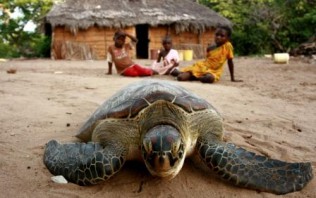Watamu Beach in Kenya attracts flocks of tourists who spend their days sunbathing, snorkeling and diving along hundreds of miles of coastline on the Indian Ocean. Yet increasing tourism—Reuters reports total visitors to Kenya as a whole rose 15.4 percent to 1.26 million in 2011—and other human-induced factors are putting marine wildlife, particularly sea turtles, increasingly at risk.
Kenya is home to five species of sea turtles, two of which are listed as critically endangered and the remaining three as endangered. The thriving fishing industry in the Watamu area presents hazards to turtles, including accidental capture in fishing nets; most of the turtles captured drown. Pollution is also taking its toll, along with erosion of nesting sites due to the construction of jetties, marinas, and hotels, The Guardian reports. The result is a difficult situation for the local workers and businesses who struggle to find a balance between revenue-generating tourism and environmentally sustainable practices.
Light and noise pollution are also major concerns. Female turtles don’t lay eggs if there is excessive noise or light, both of which are increasing in tourist hotspots along the coastline. Turtles that do hatch crawl towards the horizon to find the water, but may be confused by lights from the developing area.

The concern over sea turtles has been growing for several years. In 2008, as increasing development put pressure on local biodiversity, the Kenya Wildlife Service designed the Kenya Integrated Sea Turtle Conservation Program (KIST-Con), a three-year program that was completed in 2011. The strategy involved both local communities and government stakeholders with education, public awareness and research projects. The conservation strategy was aligned with Kenya’s Vision 2030 development blueprint, a commitment to ecotourism as a sustainable solution.
More recently, the Local Ocean Trust has organized the Watamu Turtle Watch in response to recent surges in tourism. The Guardian reports that 62% of the turtles protected at the project’s rehabilitation center are there “because of human-related causes—many associated with tourism.” While tourism helps the local economy, sea turtle habitats are slowly eroding, while their numbers are dwindling due to pollution and poaching.
The Kenya sea turtle population relies on the efforts of the Local Ocean Trust and responsible visitors. Tourists can do their part by choosing responsible accommodations and tour operators, supporting local community development and environmental awareness efforts, and putting pressure on the Kenyan government to improve environmental protection and management. If sustainable practices are implemented and supported by local authorities, people working in the tourism industry – and tourists themselves – can help revive the wildlife that makes Kenya such an attractive destination in the first place.
Read Ethical Traveler's Reprint Policy.
